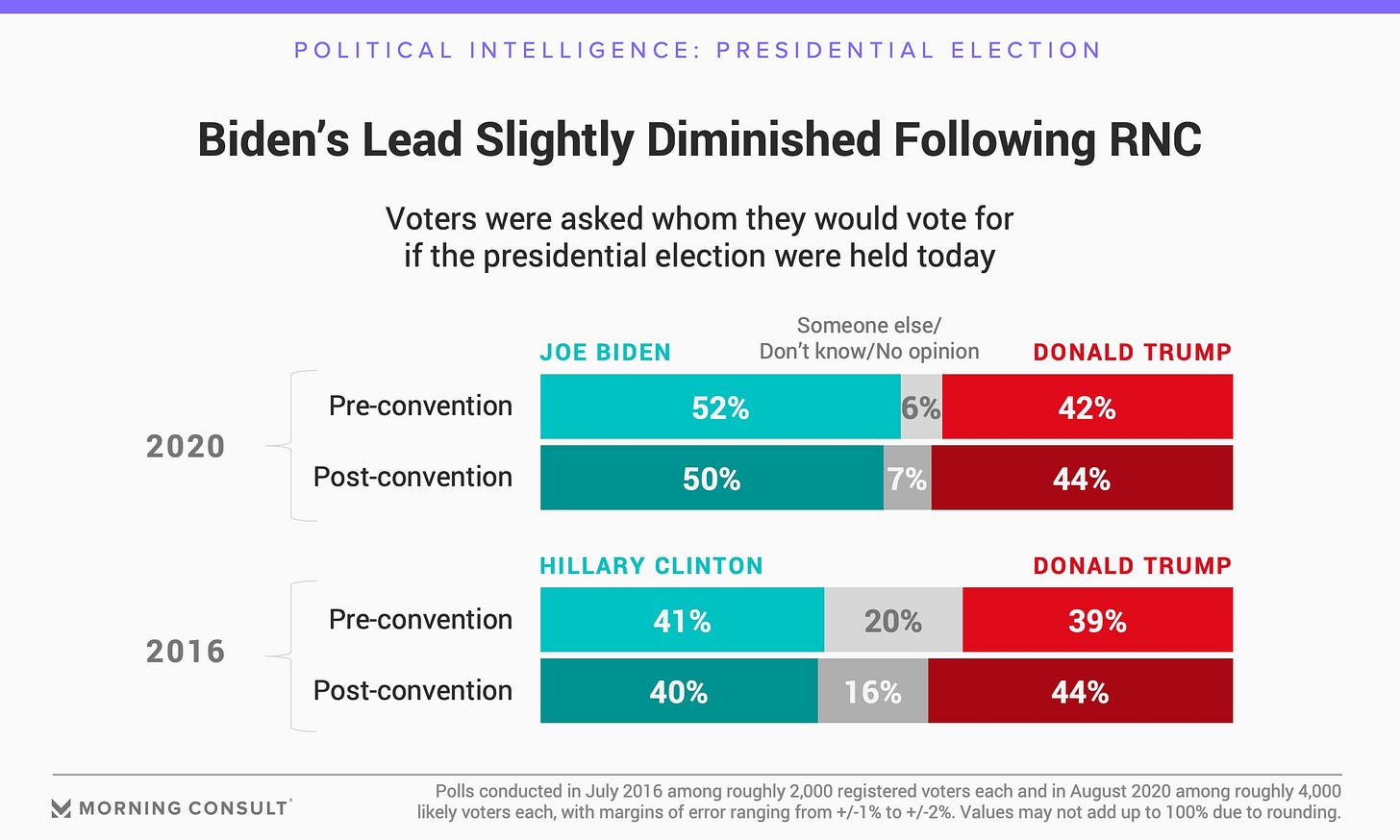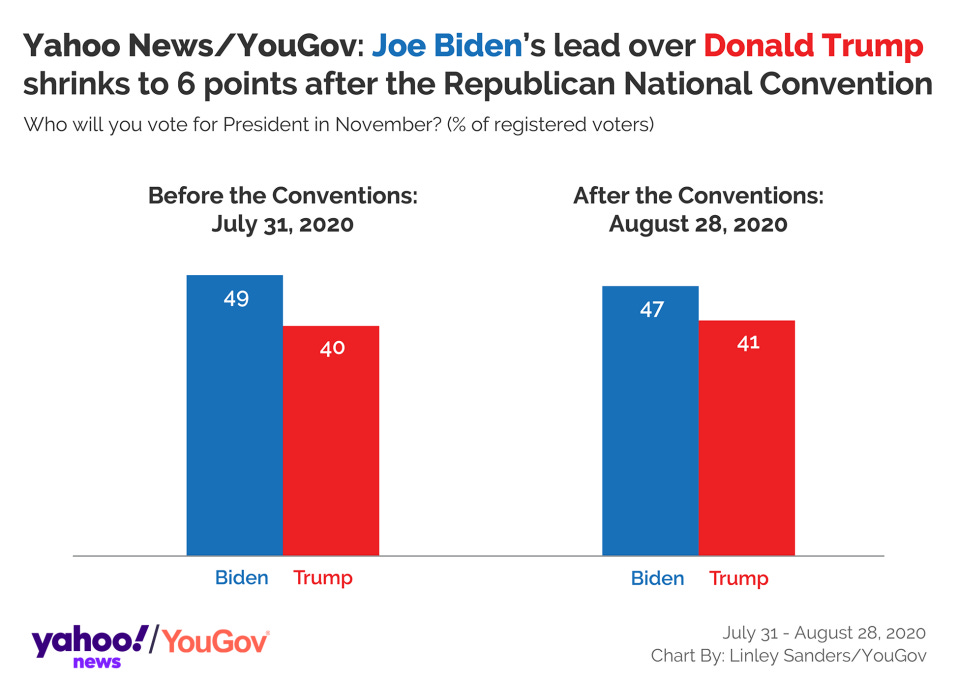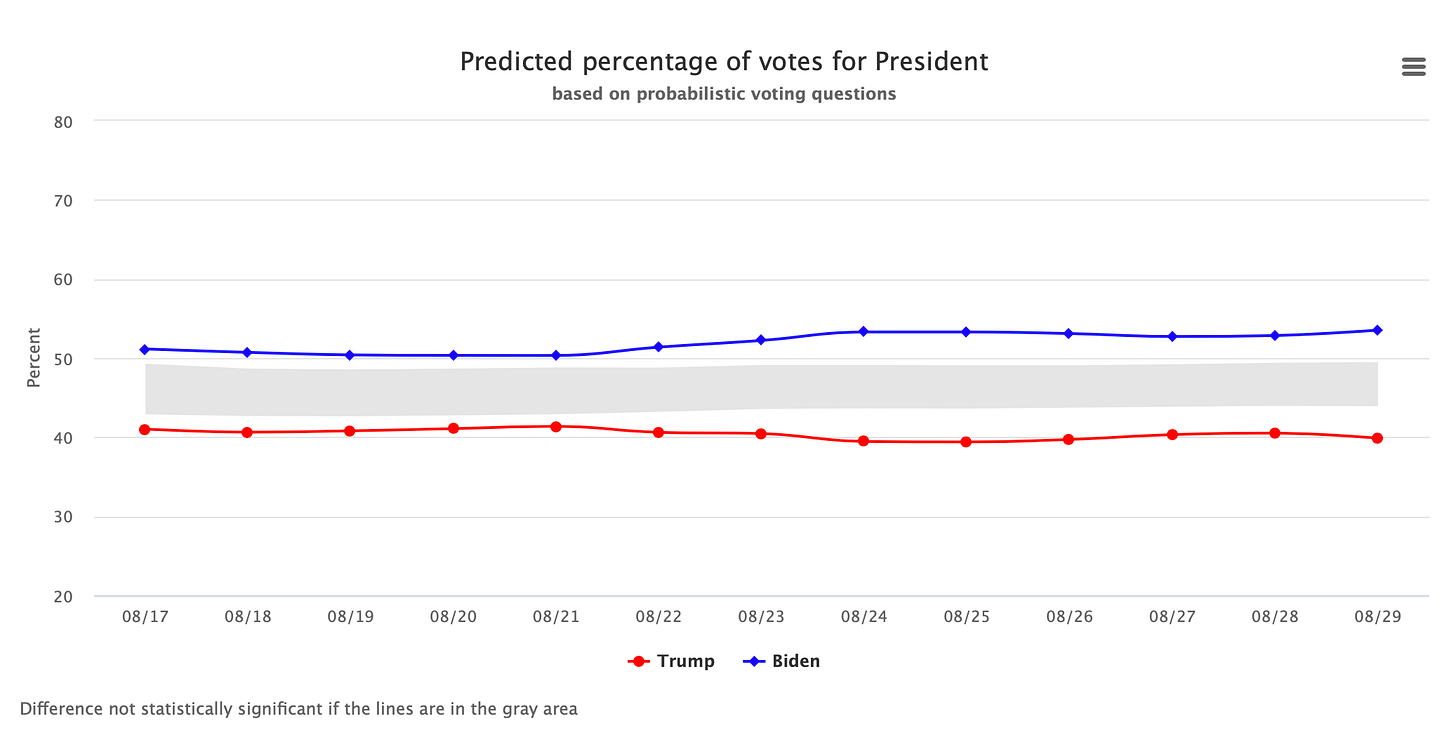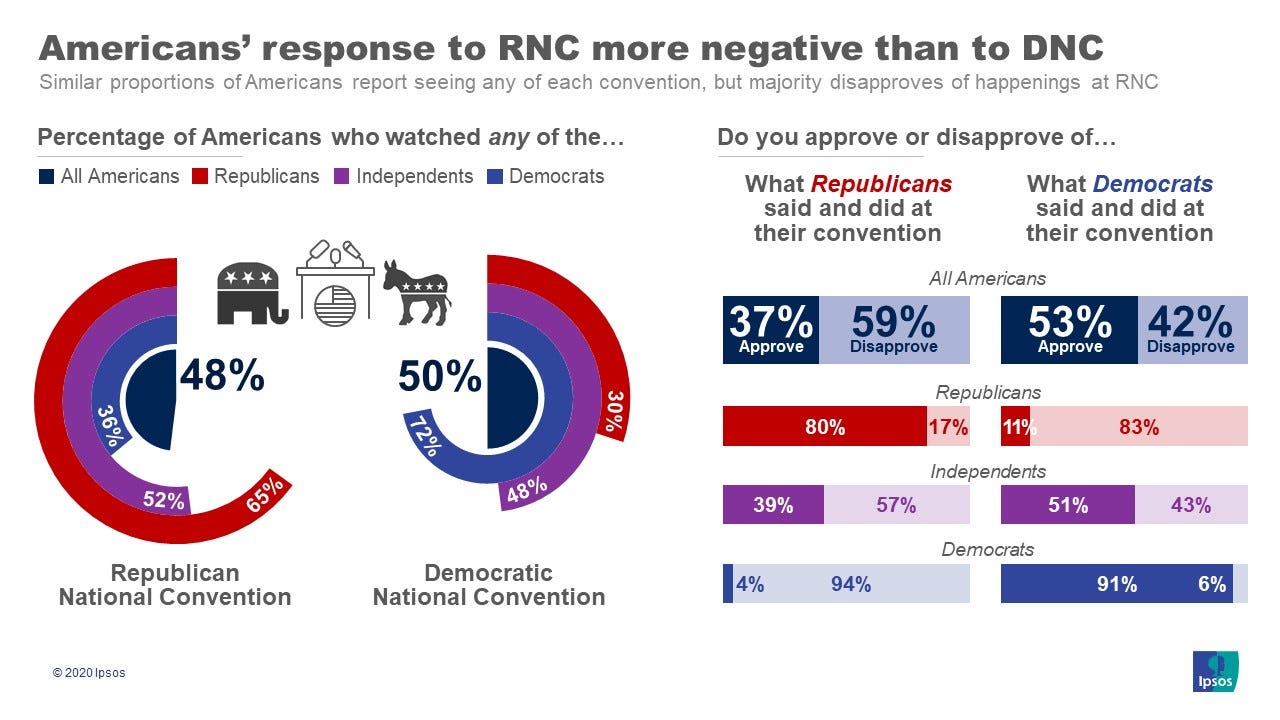It's too early to declare any poll bounce for Trump; focus on the meaning of the news instead 📊 August 30, 2020
Amid protests, partisan violence and norm violations, the presidential race enters the home stretch
The thing about always focusing on the horse race is that you lose sight of what makes a healthy horse or a well-kept track. Analysts are missing the bigger picture from the events of last week. And this is my newsletter.
As always, I invite you to drop me a line (or just respond to this email). Please hit the ❤️ below the title if you like what you’re reading; it’s our little trick to sway Substack’s curation algorithm. If you want more content, I publish subscriber-only posts 1-2x a week.
Dear reader,
Media analysts seem to be making many of the same mistakes they made in the final weeks of the 2016 election. They are drumming up horse-race coverage out of broader political controversies to keep their election coverage sexy and click-worthy. Last time around, it was ignoring how Donald Trump was playing on voters’ underlying racist and sexist attitudes and getting help from Russia in order to deliver them a hollow, self-serving presidency. This time, analysts are sidelining narratives about racial injustice, partisan violence, fascism and electoral norm-violations in favor of covering a supposedly tightening presidential race. Oh, also there’s a pandemic going on (or did you forget) while the White House ignores all the guidelines for avoiding super-spreader events.
Amid this news, massaging polls to extract horse-race coverage is not constructive. It is bad for democracy. It does not help people understand the true gravity of the election or the stakes of their decisions. As members of the fourth estate, we have to do better.
—Elliott
It's too early to declare any poll bounce for Trump; focus on the meaning of the news instead
Amid protests, partisan violence and norm violations, the presidential race enters the home stretch
Let’s talk first about the horse race, and then about how political reporters can better address this moment in history.
In regards to convention bounces: We got several new polls over the weekend that do not agree on whether Trump’s prospects have improved. If taken at face value, the data on average suggests a small, 1-2 point post-convention bounce for the president; Two polls an improved picture for Trump, one shows that Biden is gaining ground, and one shows that voters reacted negatively to the RNC.
But analyzed statistically, nothing can yet substantiate claims of a post-convention bounce for President Trump.
First, consider a new poll from Morning Consult, released Saturday. They find a four percentage point decrease in Joe Biden’s vote margin versus last weekend, just after the DNC.

But this 4-point decrease is not what pollsters would consider statistically significant. Though they polled around 4,000 people each this week and last, Morning Consult’s data cannot credibly conclude that support for Trump has increased. That’s because polls come with margins of error, and the shift between the two polls is still within the margin of error for differences in two percentages. These two graphs from my friend Natalie Jackson, a pollster for the Public Religion Research Institution, explain what’s going on:




Natalie shows that the 2-point increase in support for Trump and 2-point decrease for Biden fall inside the poll’s margin of error. At a sample size of 4,000, those differences would have to be 3-points to meet the traditional thresholds for statistical significance. And that’s before you account for the fact that the margin of error for Morning Consult’s online polls are higher than they tell you because of the degree of statistical adjustments—or “weighting”—they have to conduct in order to make the data demographically representative. Pollsters call this inflationary factor (that gets multiplied with the traditional margin of error) the “design effect” and in effect, it means that Trump would need to gain 4 or 5 points in vote share before we can conclude that the two polls are actually different.
But luckily, we have other data to consider. A new poll from YouGov conducted for Yahoo News released on Saturday showed the horse-race shifting from +9 at the end of July to +6 today. And although they only surveyed 756 voters, they were people that YouGov had surveyed before. That means that the margin of error on the difference is smaller—around two-and-a-half points rather than seven. So we can be a bit more confident that the change in YouGov’s polling is correct. We can’t say for sure how far Biden’s margin has fallen (the decline could be as small as half a point and still be inside the margin of error for the change in opinion), but, at least for this YouGov sample, we can conclude that the race has changed since July.

But there are also data that point toward Biden making gains after the RNC, again within the margin of error for the poll. Take this tracking poll from USC Dornsife for example. It shows the race shifting from Biden +12 to Biden +14 over the last two days. That seems to pour some cold water on the narrative that Trump is enjoying a convention bounce.

And finally, there is also a survey from ABC New and Ipsos that shows voters dinging their evaluations of Trump’s favorability relative to his ratings two weeks ago:


The ABC/Ipsos survey also showed that voters responded to the Republican National Convention more negatively than the Democratic one, with 59% of voters saying they disapprove of what Republicans said and did at their convention and only 42% saying the same about the Democrats.

The point is: At least for now, we cannot conclude that Trump has gotten a bounce from the Republican National Convention.
…
But the horse race update is not my overall point today. Instead, this all raises a troubling question about the media. Why, if the data don’t support the narrative that Trump has earned a bounce, do they keep treating the race like it has shifted? And more to the point of recent news of violence and murder out of Kenosha, Washington: Why do analysts keep treating unrest as “good for Trump”?
The easiest explanation is that the media craves a competitive horse race. When the race is closer and more exciting, our audiences pay attention to every new story and each new poll. They want to know, as soon as it happens, whether some event or news cycle has helped or hurt their candidate. A close race is sexy and exciting. It sells.
But there are two points to make about this. First, the broader context, which is that this is not a good way to cover elections. The important stories are not who is ahead and by how much, but about why they’re ahead and what that tells us about the public—and the country.
And for the specific context: This time, spinning the Republican convention and the events in Kenosha, Wisconsin into a Trump-favorable news cycle—where a teenager illegally carrying a rifle shot three people, killing two, after protests erupted over a police officer shooting a black man named Jacob Blake seven times in the back—ignores several very important stories about the country today.
The first, obvious story that should be covered before writing a horse race headline is about what the protests tell us about decades of police brutality and centuries of injustices against our black compatriots.
The second is about the dangers that are posed to everyday demonstrators when the president eggs on partisan violence and endorses shooting protestors. In Washington on Saturday night, people with Trump banners in the back of pickup trucks were recording driving through the streets shooting paintballs and mace at residents while they demonstrated. It’s not hard to get from there to killing protestors in the dark of night with long guns.
The third story concerns the RNC itself, where Trump violated a host of norms and laws about incumbent re-election campaign, deploying government resources to try and gain an edge over his political opponent. He used federal property for his campaign, generally seen as a no-no. He had official members of the government violate the Hatch Act and endorse him. He event sent party officials to lie to people in New York City and elicit angry responses against their Democratic leadership that he could use at his campaign. And he broke all of these norms and laws while embracing patriotism and nationalism—a warning sign to anyone familiar with how fascist parties take hold in democracies.
…
Taken together, a focus on the horse race right now is not just bad journalism, it’s a betrayal of our responsibilities as the fourth estate. We should not be spending our energy cherry-picking poll numbers to craft narratives about the election that earn us more clips or satisfy our ideological predispositions. We should be protecting the interests of the people and holding power to account. It is hard to see how many in the media are upholding those values today.
Posts for subscribers
Plus, an ungated post on recommended books about polling.
What I'm Reading and Working On
I’m on “vacation” this week to get some distance from the horse race and finish the first couple of chapters of my book. I’m reading Lost in a Gallup: Polling Failure in U.S. Presidential Elections, a new book by historian W Joseph Campbell.
Thanks for reading!
Thanks for reading. I’ll be back in your inbox next Sunday. In the meantime, follow me online or reach out via email if you’d like to engage. I’d love to hear from you.
If you want more content, I publish subscriber-only posts on Substack 1-3 times each week. Sign up today for $5/month (or $50/year) by clicking on the following button. Even if you don't want the extra posts, the funds go toward supporting the time spent writing this free, weekly letter. Your support makes this all possible!
Photo contest
Joshua called out my bias toward cat pictures last week. In order to play to both sides, here is a picture of his cute doggo Lomez.
For next week’s contest, send in a photo of your pet(s) to elliott@gelliottmorris.com.




